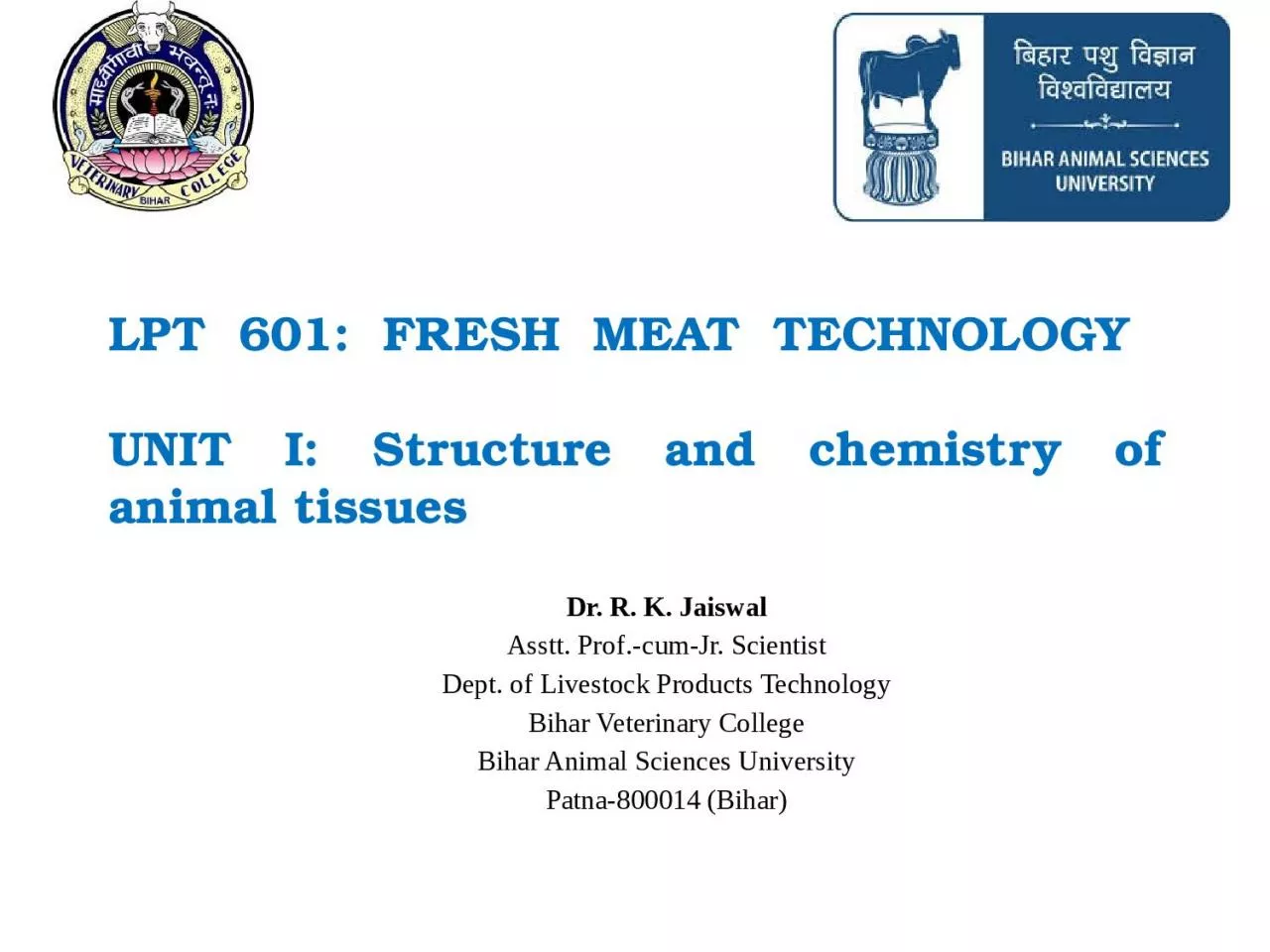

UNIT I Structure and chemistry of animal tissues Dr R K Jaiswal Asstt ProfcumJr Scientist Dept of Livestock Products Technology Bihar Veterinary College Bihar Animal Sciences University ID: 931497
Download Presentation The PPT/PDF document "LPT 601: FRESH MEAT TECHNOLOGY" is the property of its rightful owner. Permission is granted to download and print the materials on this web site for personal, non-commercial use only, and to display it on your personal computer provided you do not modify the materials and that you retain all copyright notices contained in the materials. By downloading content from our website, you accept the terms of this agreement.
Slide1
LPT 601: FRESH MEAT TECHNOLOGY UNIT I: Structure and chemistry of animal tissues
Dr. R. K. JaiswalAsstt. Prof.-cum-Jr. ScientistDept. of Livestock Products TechnologyBihar Veterinary CollegeBihar Animal Sciences UniversityPatna-800014 (Bihar)
Slide2Meat
Animal tissues which are suitable for use as food More precisely edible postmortem component originating from live animals
Slide3Meat terms
Meat ScienceThe basic study of the unique characteristics of muscle and other animal tissues that are used as meat, includes all facets of the meat industry, beginning with animal production and ending with final preparation for consumption. Meat Technology
Deals with the handling, processing, packaging, preservation and marketing of meat, meat products and byproducts at industrial scale.
Slide4Muscle tissueNervous tissuesEpithelial tissuesConnective tissuesAdipose Tissues
Muscle and Associated TissueTypes of Tissues
Slide5Types of Muscular TissueSkeletal MuscleVoluntary and striatedSmooth Muscle
Involuntary and smoothCardiac MuscleInvoluntary and striated
Slide6Skeletal Muscles
There are more than 600 muscles in animal bodyVary widely in shape, size and actions.In general Skeletal muscle constitute 35-65% of meat Muscle fiber constitute 75-92% of total muscle volume. Remaining are connective tissues, blood vessels, nerve fibers and ECF
Muscle bundle
Muscle
Muscle
Muscle fiber
Myofibril
Myofilaments
Epimysium
Perimysium
Endomysium &
Sarcolemma
Slide7Structure of Cell
Slide8Sarcolemma
Membrane surrounding the Muscle fiberMade up of protein and lipid materialElastic in natureInvaginations from Sarcolemma forming a tubular network Transverse Tubules/ T system/ T TubulesSmall mound on the surface of muscle fiber (sarcolemma) where motor nerve fiber terminate – Motor End Plate
Slide9Sarcoplasm
Cytoplasm of Muscle cellIn addition to 75-80% water contains lipid droplets, glycogen granules, ribosomes, numerous protein, NPN compounds and inorganic constituentsNucleiMultinucleatedAt tendinous attachment more concentrated and irregularly distributed.High in number at motor end plate
Peripheral in location in mammals whereas in fish central.
Slide10Myofibrils
Usually 1-2 μm in diam.Parallel to long axisFibers with diam. of 50 μm can accommodate 1000-2000 myofibrilsContractile unit is sarcomere (between two adjacent Z line)Light and dark band I Band (Isotropic/less dense) singly refractive, whereas A Band (Anisotropic/much dense) doubly refractive – I band bisection by thin dense line –Z line
Slide11Thick filaments of vertebrates 14-16 nm in diam. and 1.5
μm long (Myosin predominant/A band)Thin filaments of vertebrates 6-8 nm in diam. and 1.0 μm long on either side of Z disc (Actin predominant/ I band)Orderly arrangements of Thick and Thin filamentThick and thin overlapping in certain region accounts for striations In cross section of A band region Six thin filaments surround each thick filamentEach Actin filaments connect with 4 oblique Z filaments (Z line)
Myofilaments
Slide12Sarcoplasmic reticulum
System of Tubules and cisternae/Intracellular membrane structure acting as Flattered reservoirs of Ca2+ and corresponds to ER of other cells Thin tubules of SR oriented in direction of myofibril- Longitudinal tubules and in H zone it forms a perforated sheet called as fenestrated collar.At the junction of A and I band the longitudinal tubules join with lagers transversely oriented tubules called terminal cisternae.The T tubules also runs transversely across the sarcomere at A-I junctionConnecting elements exist between terminal cisternae and T tubules.SR and T tubules are separate, SR constitute 13% of total muscle fiber volume where as T tubules approx 0.3%.
Slide13Mitochondria
Powerhouse of cellGreat variation in mitochondrial size and their number in muscle fibersAbundant at periphery near the poles of nuclei and motor end platesAdditional at A-I band junction, Z disc and I bands
Lysosomes
Cathepsins a group of proteolytic enz.
Golgi Complex
Near the nuclei
Flattened vesicles, function as concentrating and packaging apparatus.
Slide14Slide15Slide16Sarcomere length, Dimension of I band and appearance of H Zone, Pseudo H zone and M line change with contraction state.
Slide17Slide18Slide19Slide20Innervated by the Autonomic Nervous System Found primarily in the walls of hollow organs & tubes In most of the case spindle-shaped cells typically arranged in sheets Single nucleus centrally locatedCells do not have t-tubules & have very little sarcoplasmic reticulum
No Z line or M line and striationActin and Myosin in same proportionOccurs single or in bundle and surrounded by network of reticular fiberSmooth Muscles
Slide21Two types of smooth muscle: 1. Visceral or Unitary smooth muscleFound in the walls of hollow organs (e.g., small blood vessels, digestive tract, urinary system, & reproductive system) Multiple fibers contract as a unit (because impulses travel easily across gap junctions from cell to cell) &, in some cases, are self-excitable (generate spontaneous action potentials & contractions)
2. Multiunit smooth muscle Consists of motor units that are activated by nervous stimulation Found in the walls of large blood vessels, in eye (adusting the shape of the lens to permit accommodation & the size of the pupil) Contd..
Slide22Cardiac MuscleMyocardium, the contractile layer of the heart, contains the bulk of the cardiac muscle Single centrally placed nucleus, fibers branched and shorterSarcoplasm with numerous glycogen granules Mitochondria especially large and numerous, extensive blood circulation.
Aggregates of myofilaments form fibrils of extremely variable size T Tubules at Z disc, SR less developed and terminal cisternae absent.Intercaleted disc- transecting the fiber, occurs at regular interval across I bands
Slide23Slide24Slide25Cardiac Muscle
Slide26